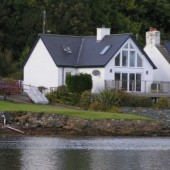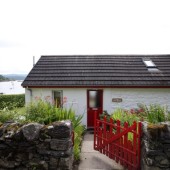A burial that took place some centuries later was that of a German sailor who was drowned when his ship when down in the Dorus Mor. His name was Alfred Goering, and we may speculate as to whether he was in any way related to the general who fought against us in the last war. His body was washed ashore, near Tigh Tuath, in a most curious fashion. The farmer living there at the time heard his dog barking, went to investigate, and saw a man apparently standing upright in the water near the shore, clinging to a ladder. On approaching, the farmer realised that he was looking at a corpse. The drowned man had tied his oilskins at the wrists with string and this had helped to keep the air inside his clothing, so that he would have floated if it had not been that his seaboots had filled with water, and this weighting him, had kept him upright. He was buried in Carsaig graveyard, a stone was put up by his brother who came from Germany to identify him and was able to do so by the buttons on his jacket which gave the name of his ship, the June of Pilau. This incident took place in 1864.
burial that took place some centuries later was that of a German sailor who was drowned when his ship when down in the Dorus Mor. His name was Alfred Goering, and we may speculate as to whether he was in any way related to the general who fought against us in the last war. His body was washed ashore, near Tigh Tuath, in a most curious fashion. The farmer living there at the time heard his dog barking, went to investigate, and saw a man apparently standing upright in the water near the shore, clinging to a ladder. On approaching, the farmer realised that he was looking at a corpse. The drowned man had tied his oilskins at the wrists with string and this had helped to keep the air inside his clothing, so that he would have floated if it had not been that his seaboots had filled with water, and this weighting him, had kept him upright. He was buried in Carsaig graveyard, a stone was put up by his brother who came from Germany to identify him and was able to do so by the buttons on his jacket which gave the name of his ship, the June of Pilau. This incident took place in 1864.
Three miles or more north of Carsaig stands Dounie, once a flourishing but now a derelict farmhouse. Here Thomas Campbell the poet lived for a time as tutor to the children of General Napier. One of his pupils was the future Sir William Napier of Milliken who was then about eight years old and was living at Dounie with his mother while his father was away in India. Dounie is even now remote and difficult of access and must have been yet more so in Thomas Campbell’s time, though there were more people living in the glen about then, but the poet, though he is said to have sometimes felt caged in, must have found inspiration in the beauty of the land around him.
At Dounie, in yet older times, the Lord of the Isles held his court. It is said that once, when a certain illdoer had been captured and convicted, he escaped and ran off. One of the Lord’s men went after him and recaptured him and brought him back for execution, and as a reward for this deed was given the lands around Dounie for his own.
Between Tayvallich and Keills lie several farms among which is Coshindrochaid, or ‘The path of the bridge’. On the marshy ground below the house are the marks of the ‘mare’s leap’. The story tells that a stranger, MacNeal, was encompassed by enemies at that place. He spurred his mare, hoping perhaps to break through the line of men in front of him, but instead the mare leaped right over their heads, a distance of 22 feet, and he was able to gallop round the head of Loch Sween and reached Castle Sween before his enemies had time to get to their boats and row across. On arrival at the castle he put his dirk into the mare and killed her saying that she had served him well and that he would not let her fall into the hands of his foes. The marks of the mare’s hooves may still be seen and it is said that however carefully they are filled in they always reappear.
There is another strange tale too about this part of the district. A packman, travelling down the road with his wares to sell, disappeared between the farms of Barrahormaid and Coshindrochaid, nothing being seen of him after the time he left the first named farm, but his umbrella and jacket. Since then a little light was often seen running up and down the wall by the road between these places. Even early in the morning men carting hay away for sale (for a great deal of hay was made and sold off these and neighbouring farms in those days) would see this light following their carts. Many years later two men from local families were digging stone out of a quarry on this road and found a skeleton which proved to be that of the packman, murdered for what he carried on him, and since the discovery and reburial of the body the light has never reappeared. Other unexplained lights, however, have been seen in this vicinity, some at quite recent dates, and by people whose integrity and common sense cannot be impugned.





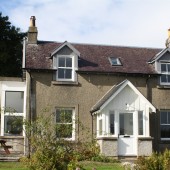
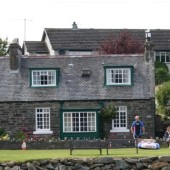
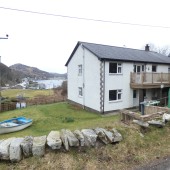
_baef36edc53bdd009ca06069d3b23fda.jpg)
